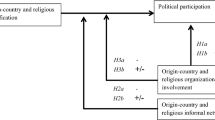Abstract
This paper uses the unique social structure of Arab communities to examine the effect of social identity on voter turnout. We first show that voters are more likely to vote for a candidate who shares their social group (signified by last name) as compared to other candidates. Using last name as a measure of group affiliation, an inverted U-shaped relationship between group size and voter turnout has been found (borderline significant) which is consistent with theoretical models that reconcile the paradox of voting by incorporating group behavior.
Similar content being viewed by others
References
Al-Haj, M. (1988). The changing Arab kinship structure: The effect of modernization in an urban community. Economic Development and Cultural Change, 36(2), 237–258.
Aldrich, J. (1993). Rational choice and turnout. American Journal of Political Science, 37(1), 246–279.
Ashworth, J., Geys, B., & Heyndels, B. (2006). Everyone likes a winner: An empirical test of the effect of electoral closeness on turnout in a context of expressive voting. Public Choice, 128, 383–405.
Ben-Bassat, A., & Dahan, M. (2008). Social identity and voter turnout. CESifo, Working paper No. 2331.
Blais, A. (2000). To vote or not to vote: The merits and limits of rational choice theory. Pittsburgh: University of Pittsburgh Press.
Bufacchi, V. (2001). Voting, rationality and reputation. Political Studies, 49(4), 714–729.
Coate, S., & Conlin, M. (2004). A group rule-utilitarian approach to voter turnout: Theory and evidence. American Economic Review, 94(5), 1476–1504.
Cohen, A. (1965). Arab border-villages in Israel. Manchester: Manchester University Press.
Edlin, A., Gelman, A., & Kaplan, N. (2007). Voting as a rational choice: Why and how people vote to improve the well-being of others. Rationality and Society, 19(1), 5–34.
Feddersen, T., & Sandroni, A. (2006). A theory of participation in elections. American Economic Review, 96(4), 1271–1282.
Filer, J. E., Kenny, L. W., & Morton, R. B. (1993). Redistribution, income, and voting. American Journal of Political Science, 37(1), 63–87.
Fowler, J. H., & Kam, C. D. (2007). Beyond the self: Social identity, altruism, and political participation. The Journal of Politics, 69(3), 813–827.
Geys, B. (2006). ‘Rational’ theories of voter turnout: A review. Political Studies Review, 4, 16–35.
Goldberg, G. (2001). The changes in the behavior of Israeli voter in local elections. In E. Daniel & C. Klchheim (Eds.), Local government in Israel. Jerusalem: Center for Public Policy.
Großer, J., & Schram, A. (2006). Neighborhood information exchange and voter participation: An experimental study. American Political Science Review, 100(2), 235–248.
Grossman, G., & Helpman, E. (2001). Special interest politics. Cambridge: MIT Press.
Harsani, J. C. (1980). Rule utilitarianism, rights, obligations and the theory of rational behavior. Theory and Decision, 12(2), 115–133.
Huddy, L. (2003). Group identity and political cohesion. In D. O. Sears, L. Huddy, & R. Jervis (Eds.), Oxford handbook of political psychology.
Jankowski, R. (2002). Buying a lottery ticket to help the poor: Altruism, civic duty and self-interest in the decision to vote. Rationality and Society, 14(1), 55–77.
Jankowski, R. (2007). Altruism and decision to vote: Explaining and testing high voter turnout. Rationality and Society, 19(1), 5–34.
Landau, Y. (1993). The Arab minority in Israel, 1967–1991: Political dimensions. Am Oved: Eshkol/Hebrew University.
Lapp, M. (1999). Incorporating groups into rational choice explanations of turnout: An empirical test. Public Choice, 98, 171–185.
Matsusaka, J. G., & Palda, F. (1993). The Downsian voter meets the ecological fallacy. Public Choice, 77, 855–878.
Morlan, R. L. (1984). Municipal vs. national election voter turnout: Europe and the United States. Political Science Quarterly, 99(3), 457–470.
Morton, R. B. (1991). Groups in rational turnout models. American Journal of Political Science, 35(3), 758–776.
Ozacky-Lazar, S. (2005). 2003 local election in Arab municipalities—An overview. In E. Rekhess & S. Ozacky-Lazar (Eds.), Local elections in Arab and Druze municipalities (2003): Hamulote, ethnic groups and political parties. Tel-Aviv: Tel-Aviv University.
Reingewertz, Y. (2009). The political economy of local government crisis in Israel. In A. Ben-Bassat & M. Dahan (Eds.), The political economics of local government in Israel. Jarusalem: Israel Democracy Institute Press.
Riker, W. H., & Ordeshook, P. C. (1968). A theory of the calculus of voting. The American Political Science Review, 62(1), 25–42.
Rosenfeld, H. (1974). Hamula. The Journal of Peasant Studies, 1(2), 43–244.
Schram, A. (1991). Voting behavior in comparative perspective. Berlin: Springer.
Schram, A., & Sonnemans, J. (1996). Why people vote: Experimental evidence. Journal of Economic Psychology, 17, 417–442.
Schram, A., & Van Winden, F. (1991). Why people vote: Free riding and the production and consumption of social pressure. Journal of Economic Psychology, 12, 575–620.
Schwartz, T. (1987). Your vote counts on account of the way it is counted: An institutional solution to the paradox of not voting. Public Choice, 54, 101–121.
Shachar, R., & Nalebuff, B. (1999). Follow the leader: Theory and evidence on political participation. American Economic Review, 89, 525–547.
Shamir, M., & Arian, A. (1999). Collective identity and electoral competition in Israel. American Political Science Review, 93(2), 265–277.
Shavit, Y., & Pierce, J. (1991). Sibship size and educational attainment in nuclear and extended families: Arabs and Jews in Israel. American Sociological Review, 56(3), 321–330.
Stacklov, O. (2008). On the effectiveness of central government control on fiscal performance of local government in Israel. Mimeo.
Tajfel, H. (1981). Human groups and social categories. Cambridge: Cambridge University Press.
Uhlaner, C. J. (1989). Rational turnout: The neglected role of groups. American Journal of Political Science, 33(2), 390–422.
Author information
Authors and Affiliations
Corresponding author
Rights and permissions
About this article
Cite this article
Ben-Bassat, A., Dahan, M. Social identity and voting behavior. Public Choice 151, 193–214 (2012). https://doi.org/10.1007/s11127-010-9742-2
Received:
Accepted:
Published:
Issue Date:
DOI: https://doi.org/10.1007/s11127-010-9742-2




